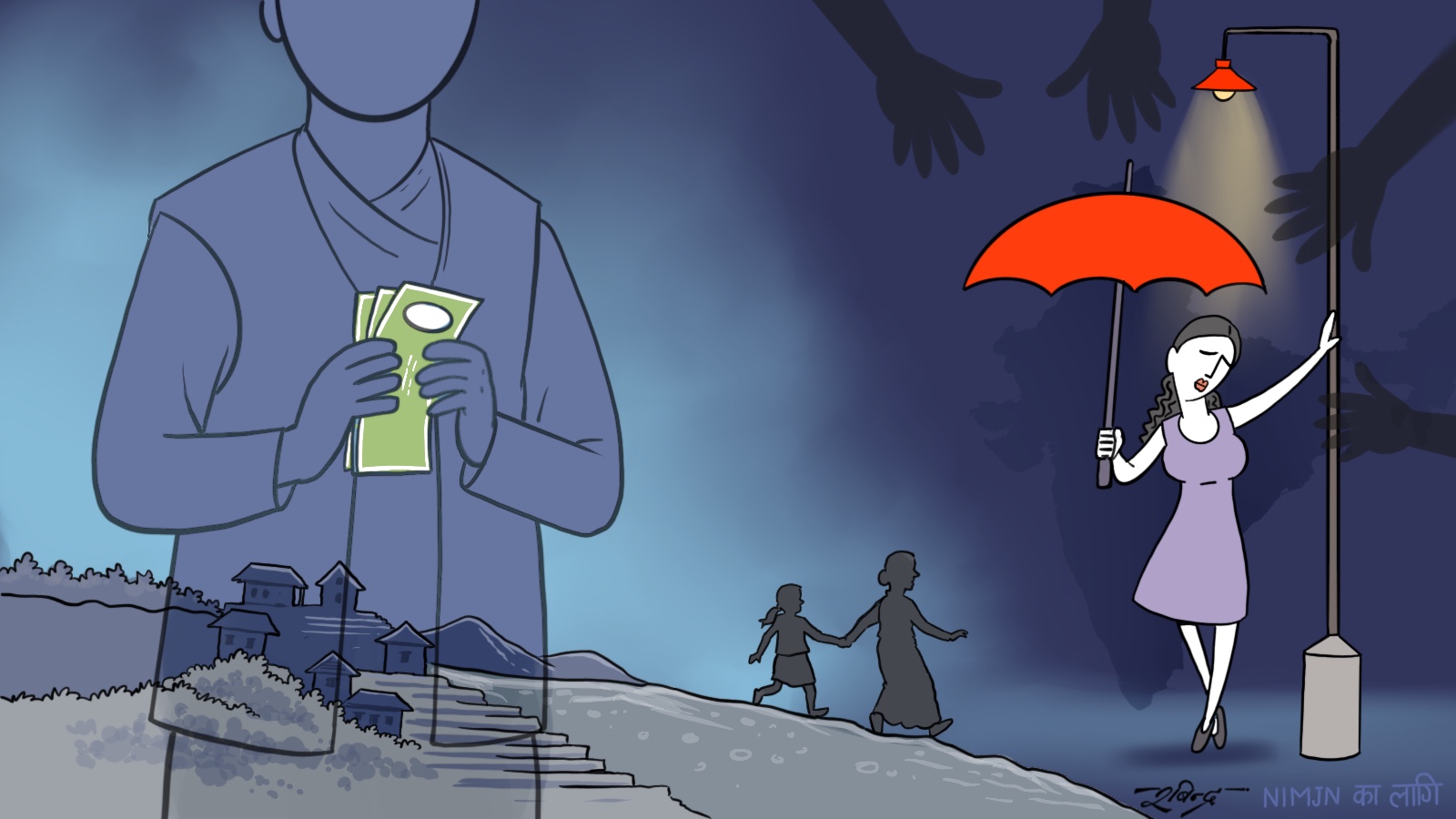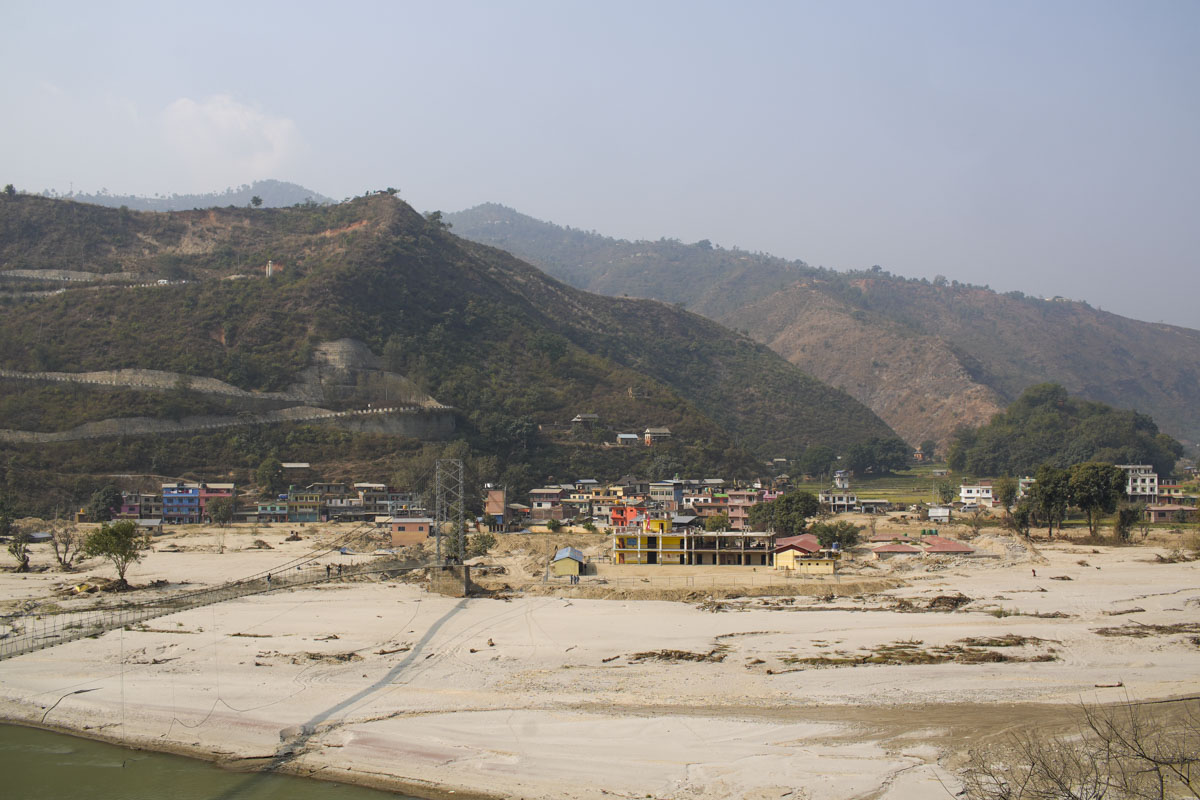Read the story in Nepali: अन्नपूर्णको काखमा रहेको पञ्चकुण्ड हिमताल : किन बढ्दै छ आकार ?
A glacial lake that has formed at the North Annapurna Base Camp and the changes observed in it demonstrate the geographical and environmental shifts taking place in Nepal's Himalayan regions due to climate change.
Tej Bahadur Gurung, an activist working to promote the Mt. Annapurna I climbing route, saw five ponds when he first reached the North Base Camp in 2073 BS (2016). These five ponds, situated at an altitude of 4,050 meters, have now merged, disappearing to form a single large lake. “Since we first saw five ponds, we named the glacial lake Panchkund (Five Ponds),” he says. “Over the last nine years, the five kunds (ponds) of Panchkund have melted and formed a single large lake.”
 This glacial lake, nestled in the lap of Annapurna I, Nilgiri, and Tilicho peaks, is located in Annapurna Rural Municipality, Ward No. 4, Myagdi. Although someone named this lake ‘Dikicho’ on Google Maps, the Rural Municipality has put up a board calling it Panchkund Lake.
This glacial lake, nestled in the lap of Annapurna I, Nilgiri, and Tilicho peaks, is located in Annapurna Rural Municipality, Ward No. 4, Myagdi. Although someone named this lake ‘Dikicho’ on Google Maps, the Rural Municipality has put up a board calling it Panchkund Lake.
A satellite image from 1990, 25 years before Tej Bahadur saw the five ponds at the North Annapurna Base Camp, shows no lake or pond there at all.
According to Indra Singh Sherchan, who reached the base camp via Lete, Mustang around 1995, 30 years ago, as a mountaineer’s helper, there were small ponds on the ice next to the glacier at that time. The place where the lake is now was previously a glacier. Mountaineers used to climb to the upper base camp along the edge of that glacier. After the base camp of that time was swept away by an avalanche from the Tilicho Peak side, a new base camp was established a bit lower, at the foothills of Tilicho Peak itself.
According to the article ‘North Annapurna Glacier Retreat and Lake Development’ published in 2022 by Maury Pelto, Professor of Environmental Science at Nichols College in the USA, Panchkund Glacial Lake did not exist until 1988. There was an active glacier about 1.5 kilometers long there.
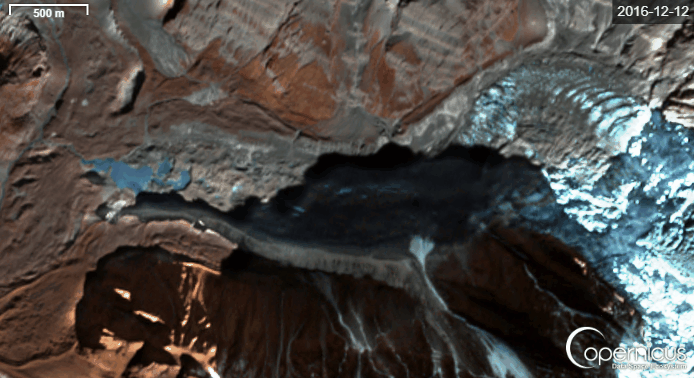
It only began to take the shape of a proglacial lake from 2001 onwards. Since then, the size of the glacial lake has been increasing rapidly.
According to Finu Shrestha, a Remote Sensing and Geo-Information Analyst at the International Centre for Integrated Mountain Development (ICIMOD), the size of this glacial lake has increased by 846 percent in the last 12 years. The lake formed at the foot of Annapurna and the changes observed in it demonstrate the geographical and environmental shifts taking place in Nepal's Himalayan regions due to climate change.
Indra Singh Sherchan, active in the Annapurna Base Camp area for tourist search, rescue, and assistance, says, “I watched the glacier melt and turn into a lake; the crevasses on the paths mountaineers use to climb the mountain are tearing and falling away, and I fear that the climbing route and the glacial lake will be destroyed within a few years.”
According to ICIMOD, the glacial lake, which covered an area of 0.041 square kilometers in 2013, has grown to 0.388 square kilometers by 2025. The size of the lake observed in 2013 tripled to 0.115 square kilometers in 2015.
The lake grew further to 0.216 square kilometers by 2021. After that, the speed of the lake’s expansion appears frightening in four years. Between 2022 and 2025, the lake’s surface area nearly doubled, reaching 0.288 square kilometers.
Activist Tej Bahadur attributes the change in this lake to climate change and rising temperatures. He expresses concern, saying that this indicates the environment of the Annapurna I Base Camp itself is becoming vulnerable. He says, “It saddens me to see the islands of ice within the lake disappear and be destroyed.”
In high mountainous regions, continuous snowfall piles up, and that snow compacts to form thick ice. This thick mass of ice hangs down from the top between two mountain gorges; this mass of ice is the glacier. When snow accumulates on a steep mountain slope, avalanches occur from time to time. Sometimes, not only snow but also parts of the mountain collapse and fall. At the base of the mountain, there is ice mixed with snow, soil, and rocks, which is called permafrost.
Ponds of water formed on thick ice after a glacier melts are called proglacial lakes. Proglacial lakes form when a proglacial area expands, or when the meltwater of a glacier or permafrost in a glacier’s flow path is blocked by mounds of rock and soil. This glacial lake developed at the base of Annapurna I was formed after the glacier was blocked by mounds of rock and soil.

Due to climate change, temperatures are also rising in the Himalayan region. ICIMOD's High-Vis report, published in 2023, mentions that due to climate change in the Hindu Kush Himalayan region, glaciers are melting faster, the number of snowfall days is decreasing, and permafrost is thawing, leading to major changes in the Himalayan region.
These changes have increased the rate of glacier melting. Snowmelt from the upper region of the lake has increased the water level in the lake. Similarly, the rise in temperature has also caused the ice within the lake to melt faster, resulting in its increased size.
The Department of Hydrology and Meteorology called 2023 the hottest year in four decades. According to the department, the maximum temperature record was broken in 12 places in Nepal in 2023. In 2023, the average maximum temperature in Nepal was 27.9 degree Celsius (0.6 degree Celsius higher than normal), and the average minimum temperature was 15.6 degree Celsius (0.5 degree Celsius higher than normal). According to the department, the average annual maximum temperature in Nepal during the 1980s was 26.4 degree Celsius.
The effect of this temperature rise has also been felt in the Himalayan region. According to the department's records, the low level of snowfall in the Himalayan region in January-February 2024 led to a significant reduction in the amount of snow.
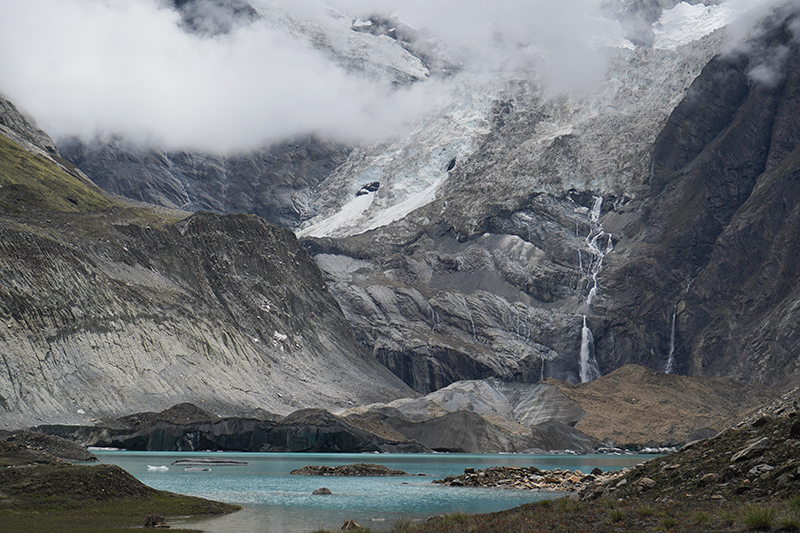
The High-Vis report also warns that due to the excessive temperature rise in Nepal's Himalayan region in 2023 and the extreme lack of snowfall in 2024, the water availability in the Himalayan region will peak by the end of the century and then gradually decline.
Arun Bhakta Shrestha, Regional Program Director for River Basins and Cryosphere at ICIMOD, says that even if the temperature rise in the Himalayan region can be limited to at least 1.5 degree Celsius, we will still lose 30 percent of the snow from the Hindu Kush Himalayan region by the end of the century. “If global warming goes above 1.5 degree Celsius, it is estimated that more than 70 percent of the snow will melt from the Himalayan region,” he says. “This will lead to water shortages in the dry Himalayan regions of the Hindu Kush, including Mustang, Manang, Dolpa in Nepal, and Ladakh in India, Pakistan, and Afghanistan.”
Increasing Human Activity
Annapurna I, at 8,091 meters high, known as the eldest mountain in mountaineering history, was successfully summited on June 3, 1950, by a team led by French mountaineer Maurice Herzog, along with Louis Lachenal and two Nepali Sherpas.
They followed the traditional sheep herder’s route through Humkhola, Bhusket Mela, above Narchyang village, at the base of Nilgiri South, to reach Annapurna I. Sixty-two years later, in 2012, local residents reached the Annapurna Base Camp to re-establish this lost but historical trekking route and began promoting this glacial lake.
The glacial lake at the base camp has become a major attraction not only for Annapurna I climbers but also for domestic tourists visiting during the spring and autumn seasons. The Annapurna Rural Municipality has made tourism its main revenue source, and local residents have found it a good means of income. This year, the Rural Municipality has leased the hotel business to entrepreneurs for Rs. 77,000 to provide facilities for tourists visiting Panchkund Glacial Lake and the base camp.
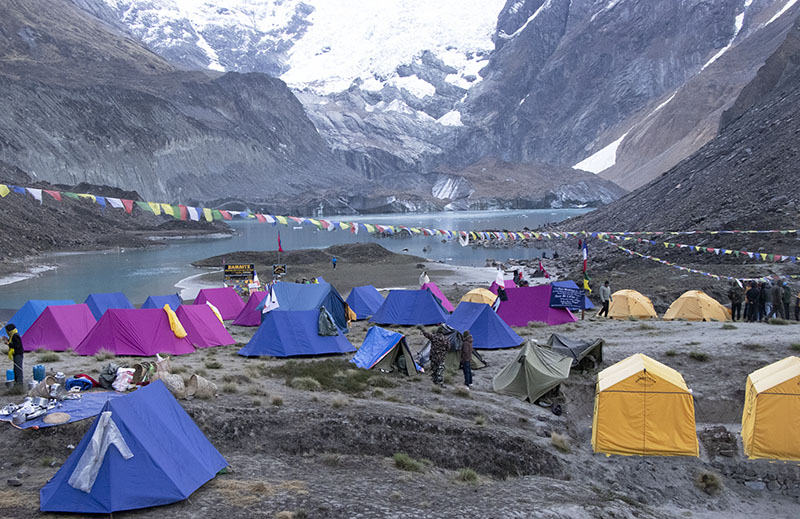
After the locals established the trekking route, the number of tourists reaching here has also increased recently. While the data for mountaineers climbing Annapurna I is kept by the Department of Tourism and the Annapurna Conservation Area Project, there is no body that keeps track of Nepali and Indian tourists visiting Panchkund Glacial Lake at the base camp.
However, entrepreneurs estimate that more than 12,000 tourists reached Panchkund Lake in this Asoj and Kartik (mid-September to mid-November) alone. Tej Bahadur Gurung, who runs a hotel business in Humkhola, says, “More than 12,000 tourists reached Annapurna Base Camp by the third week of Asoj and Kartik (mid-September to mid-November) this season, and 300 tourists were at the base camp alone during the two days of unseasonal snowfall recently."
Along with tourism, garbage has increased around the lake. Bharat Kumar Pun, Chairman of the Annapurna Rural Municipality, is enthusiastic about tourist arrivals but expresses concern when he thinks about the future of the lake.
Hari Krishna Shrestha, a veteran tourism entrepreneur and politician from Beni, says that 10-15 thousand tourists arriving in a single season will not only pollute the lake but also have an environmental impact.
To conserve the environment of the glacial lake and keep the risks under control, tourists also need to develop an eco-friendly travel culture. “It is necessary for the local government and other stakeholders to put up awareness boards about the Himalayan environment along the trail, run lake conservation programs, restrict random entry of people, and implement conservation programs using both local and technical knowledge at the lake’s water outlet,” says Finu from ICIMOD. She clarifies that ICIMOD has implemented the same practice in glacial lakes in other areas.
Study Required for Risk Assessment
Chairman Bharat Kumar says that since the outlet for the lake's water is open, there is no immediate risk of the lake bursting. However, he says that protection, including embankments, is necessary in the lake's water outlet area.
Finu from ICIMOD also says that while there is no risk of the lake bursting, a study using geo-radar, seismic, and electrical ERT equipment is necessary to determine the lake's condition.
“It does not look like the moraine dam of the Annapurna glacial lake will suddenly burst, leading to a glacial lake outburst flood,” she says. “But the active layer of the Annapurna glacier appears to be broken, and the debris-covered glacier seems to be melting rapidly, which is a frightening sign of sudden change in the glacier due to climate change.”
"As beautiful as the Annapurna glacial lake is to look at, it seems to be putting the future at risk," said Anita Acharya, Assistant Chief District Officer of Myagdi, who returned after observing Panchkund Glacial Lake. She says that environmental conservation and risk reduction work along the banks are necessary in the lake area. The lake water mixes with the Kali Gandaki River after flowing through the Mistri stream to Guinthe in Dana.

Pradeep Pun, Headmaster of Tikot Secondary School, who visited the location two years ago, says that hearing news of glacial lakes bursting elsewhere makes him fear that this lake will burst someday. “Our local body has only seen money growing at the Annapurna glacial lake and base camp, but not the future risk,” he says. “The head of the local body is also a friend; my request is that the local body should bring in experts on glacial lakes and conduct a detailed study of the Annapurna glacial lake.”
Since glacial lakes are a sensitive issue, regular monitoring, measurement of water flow, and recording of temperature are essential, requiring the attention of the local, provincial, and federal governments. Chitra Bahadur Tilija, a tourism worker running ecotourism with community participation, says, “Everyone needs to change the way they view the glacial lake; it is not just beauty but also a warning.”
A detailed geological risk assessment study of this glacial lake has not been carried out so far. Bharat Kumar, Chairman, and Diwakumari Tilija, Vice-Chairwoman of Annapurna Rural Municipality, state that since the local body lacks the technology, technical knowledge, skill, and manpower to conduct a detailed study of the lake, they will make the necessary effort.
Please adhere to our republishing policy if you'd like to republish this story. You can find the guidelines here.

